
Palm wine, known by several local names, is an alcoholic beverage created from the sap of various species of palm trees such as the palmyra, date palms, and coconut palms. It is known by various names in different regions and is common in various parts of Africa, the Caribbean, South America, South Asia, Southeast Asia, and Micronesia.

Jaggery is a traditional non-centrifugal cane sugar consumed in the Indian subcontinent, Southeast Asia, North America, Central America, Brazil and Africa. It is a concentrated product of cane juice and often date or palm sap without separation of the molasses and crystals, and can vary from golden brown to dark brown in colour. It contains up to 50% sucrose, up to 20% invert sugars, and up to 20% moisture, with the remainder made up of other insoluble matter, such as wood ash, proteins, and bagasse fibres. Jaggery is very similar to muscovado, an important sweetener in Portuguese, British and French cuisine. The Kenyan Sukari ngutu/nguru has no fibre; it is dark and is made from sugarcane and also sometimes extracted from palm tree.

Upma, uppumavu, or uppittu is a dish of thick porridge from dry-roasted semolina or coarse rice flour. Upma originated from South India, and is most common in Kerala, Andhra Pradesh, Tamil Nadu, Odisha, Telangana, Karnataka, Maharashtra, and in Sri Lankan Tamil communities. Often, depending on preference, it has various seasonings and/or vegetables added during cooking.

Borassus is a genus of five species of fan palms, native to tropical regions of Africa, Asia, and Papua New Guinea.

Penang cuisine is the cuisine of the multicultural society of Penang, Malaysia. Most of these cuisine are sold at road-side stalls, known as "hawker food" and colloquially as "muckan carts". Local Penangites typically find these hawker fares cheaper and easier to eat out at due to the ubiquitousness of the hawker stalls and that they are open for much of the day and night. Penang island. On February 22, 2013, Penang was ranked by CNN Travel as one of the top ten street food cities in Asia. Penang has also been voted by Lonely Planet as the top culinary destination in 2014.
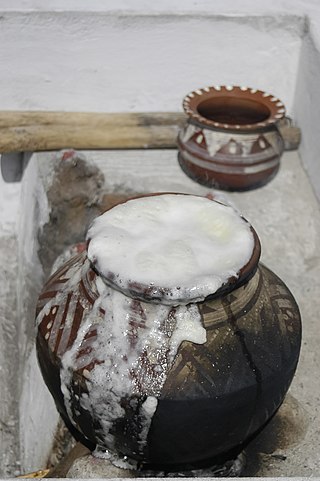
Pongal is a South Indian and Sri Lankan dish of rice cooked in boiling milk. Its preparation is the main custom associated with the Pongal festival. It is also eaten as a breakfast food. A part of Tamil cuisine, varieties include venn (hot) pongal, sakkarai (sweet) pongal, kozhi (chicken) pongal, and sanyasi pongal. It has been described as "very dear to (the) Tamil people."

Idiyappam, also known as indiappa, noolappam, santhagai, or ottu shavige, is a string hopper dish originating from southern India. It consists of rice flour pressed into noodles, laid into a flat disc-like shape and steamed. The dish also spread to Southeast Asia, where it is called putu mayam in Malaysia and Singapore, and putu mayang in Indonesia.

Palm sugar is a sweetener derived from any variety of palm tree. Palm sugar is sometimes qualified by the type of palm, as in coconut palm sugar. While sugars from different palms may have slightly different compositions, all are processed similarly and can be used interchangeably.

A rice cake may be any kind of food item made from rice that has been shaped, condensed, or otherwise combined into a single object. A wide variety of rice cakes exist in many different cultures in which rice is eaten. Common variations include cakes made with rice flour, those made from ground rice, and those made from whole grains of rice compressed together or combined with some other binding substance.

An uttapam is a type of dosa from South India. Unlike a typical dosa, which is crisp and crepe-like, an uttapam is thicker, with toppings. The name is derived from the Tamil words appam and utthia or uttria, meaning "poured appam", because appam is cooked in a round-bottom pan, whereas utthia-appam is cooked on a flat skillet. Tamil ancient literature mentions it by name. The classic breakfast of Tamil residents consists of idli, dosas or uttappams mostly accompanied by sambar and chutney.

Ragi mudde, ragi sangati or kali, colloquially simply referred to as either mudde or hittu which means 'lump' or 'dough', is a finger millet swallow dish of India in the state of Karnataka and Andhra Pradesh. In Tamil Nadu, especially in western Tamil Nadu, it is also called ragi kali. Ragi mudde is the main food in Kolar, Mandya, Hassan, Mysore, Tumkur, Bengaluru Rural, Ramanagar districts in Karnataka and Rayalaseema Region in Andhra Pradesh. A similar variation known as dhindo is also eaten in Northeast India, Nepal and Bhutan. In Uttarakhand and Himachal Pradesh in northern India, a similar variation is known as baadi and baari respectively.
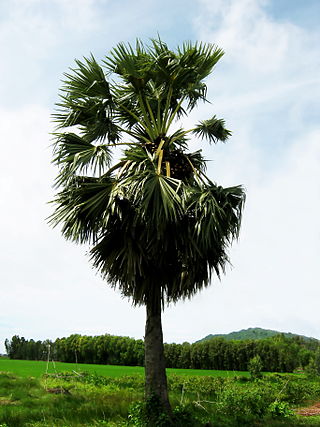
Borassus flabellifer, commonly known as doub palm, palmyra palm, tala or tal palm, toddy palm, lontar palm, wine palm, or ice apple, is a fan palm native to South Asia and Southeast Asia. It is reportedly naturalized in Socotra.

Lontong is an Indonesian dish made of compressed rice cake in the form of a cylinder wrapped inside a banana leaf, commonly found in Indonesia, Malaysia, and Singapore. Rice is rolled inside a banana leaf and boiled, then cut into small cakes as a staple food replacement for steamed rice. The texture is similar to that of ketupat, with the difference being that the ketupat container is made from woven janur fronds, while lontong uses banana leaf instead.

Palm-leaf manuscripts are manuscripts made out of dried palm leaves. Palm leaves were used as writing materials in the Indian subcontinent and in Southeast Asia dating back to the 5th century BCE. Their use began in South Asia and spread to other regions, as texts on dried and smoke-treated palm leaves of the Palmyra or talipot palm. Their use continued until the 19th century when printing presses replaced hand-written manuscripts.

Bamboo shoots or bamboo sprouts are the edible shoots of many bamboo species including Bambusa vulgaris and Phyllostachys edulis. They are used as vegetables in numerous Asian dishes and broths. They are sold in various processed shapes and are available in fresh, dried, and canned versions.

Malaysian Indian cuisine, or the cooking of the ethnic Indian communities in Malaysia, consists of adaptations of authentic dishes from India, as well as original creations inspired by the diverse food culture of Malaysia. Because the vast majority of Malaysia's Indian community are of South Indian descent, and are mostly ethnic Tamils who are descendants of immigrants from a historical region which consists of the modern Indian state of Tamil Nadu and Sri Lanka's Northern Province, much of Malaysian Indian cuisine is predominantly South Indian-inspired in character and taste. A typical Malaysian Indian dish is likely to be seasoned with curry leaves and whole and powdered spice, and to contain fresh coconut in various forms. Ghee is still widely used for cooking, although vegetable oils and refined palm oils are now commonplace in home kitchens. Before a meal it is customary to wash hands as cutlery is often not used while eating, with the exception of a serving spoon for each respective dish.

Khanom chin or Khanom jeen are fresh, thin rice noodles in Thai cuisine which are made from rice sometimes fermented for three days, boiled, and then made into noodles by extruding the resulting dough through a sieve into boiling water. Khanom chin is served in many kinds of stock: coconut milk, fish curry, and chilli.
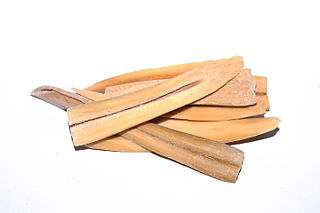
Odiyal is a hard snack made from palmyra palm tubers. Generally, it is split in two and dried until it gets hard. Odiyal can be prepared in another form, called pulukodiyal. Pulukodiyal is prepared by boiling and then drying. It is used to produce Pulukodiyal flour.
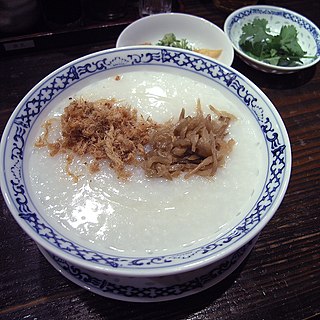
Congee is a form of savoury rice porridge made by boiling rice in a large amount of water until the rice softens. Depending on rice–water ratio, the thickness of congee varies from a Western oatmeal porridge to a gruel. Since the history of rice cultivation in Asia stretches back to the Baiyue-inhabited lower Yangtze circa 10,000 BC, congee is unlikely to have appeared before that date. Congee is typically served with side dishes, or it can be topped with meat, fish, and pickled vegetables.
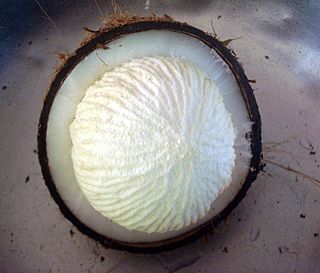
Sprouted coconuts, also referred to as coconut sprouts, are the edible spherical sponge-like cotyledons of germinating coconuts. They have a crunchy watery texture with a slight sweetness. They are eaten in coconut-growing countries either as is or as part of various dishes. They are not commercially produced. They are also known variously as coconut pearls, coconut embryos, coconut candy, coconut apples, coconut cotyledons or simply coconembryos or coconapples.




















